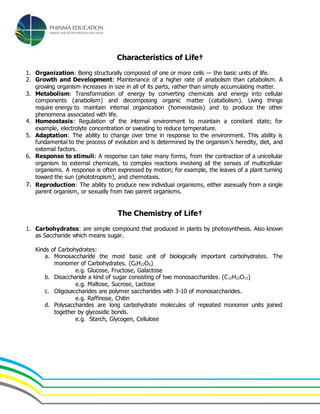Bio 034 hand-out 2 - Characteristics of Life & Chemistry of Life
•Download as DOCX, PDF•
0 likes•328 views
The document outlines 7 characteristics of life: 1. Organization into cells 2. Growth and development through metabolism 3. Metabolism to transform energy and build cellular components 4. Homeostasis to maintain internal stability 5. Ability to adapt in response to the environment 6. Response to external stimuli 7. Ability to reproduce It also describes the basic chemistry of life, including the roles of carbohydrates, lipids, nucleic acids, proteins, and water. Carbohydrates include sugars that store and provide energy. Lipids provide energy and make up cell structures. Nucleic acids like DNA and RNA are essential and contain nucleotides with nitrogen bases. Proteins are made of amino acids and
Report
Share
Report
Share

Recommended
Recommended
More Related Content
What's hot
What's hot (18)
Similar to Bio 034 hand-out 2 - Characteristics of Life & Chemistry of Life
Similar to Bio 034 hand-out 2 - Characteristics of Life & Chemistry of Life (20)
1. Introduction to structure of biomolecules lecture Lecture 2-1.pptx

1. Introduction to structure of biomolecules lecture Lecture 2-1.pptx
After reading the text, please describe the 3 types of chemical bond.docx

After reading the text, please describe the 3 types of chemical bond.docx
Chapter 5 Nutrition.pptx jiofjdiojsfiojifojiosdjiojfiosdjiojdiojiji...

Chapter 5 Nutrition.pptx jiofjdiojsfiojifojiosdjiojfiosdjiojdiojiji...
More from Jaycris Agnes
More from Jaycris Agnes (19)
Ecological Genetics: Adaptation and Natural Selection 

Ecological Genetics: Adaptation and Natural Selection
Recently uploaded
Recently uploaded (20)
National Biodiversity protection initiatives and Convention on Biological Di...

National Biodiversity protection initiatives and Convention on Biological Di...
Predicting property prices with machine learning algorithms.pdf

Predicting property prices with machine learning algorithms.pdf
Cancer cell metabolism: special Reference to Lactate Pathway

Cancer cell metabolism: special Reference to Lactate Pathway
SAMPLING.pptx for analystical chemistry sample techniques

SAMPLING.pptx for analystical chemistry sample techniques
The ASGCT Annual Meeting was packed with exciting progress in the field advan...

The ASGCT Annual Meeting was packed with exciting progress in the field advan...
Comparative structure of adrenal gland in vertebrates

Comparative structure of adrenal gland in vertebrates
PRESENTATION ABOUT PRINCIPLE OF COSMATIC EVALUATION

PRESENTATION ABOUT PRINCIPLE OF COSMATIC EVALUATION
platelets- lifespan -Clot retraction-disorders.pptx

platelets- lifespan -Clot retraction-disorders.pptx
insect taxonomy importance systematics and classification

insect taxonomy importance systematics and classification
Earliest Galaxies in the JADES Origins Field: Luminosity Function and Cosmic ...

Earliest Galaxies in the JADES Origins Field: Luminosity Function and Cosmic ...
Gliese 12 b, a temperate Earth-sized planet at 12 parsecs discovered with TES...

Gliese 12 b, a temperate Earth-sized planet at 12 parsecs discovered with TES...
Circulatory system_ Laplace law. Ohms law.reynaults law,baro-chemo-receptors-...

Circulatory system_ Laplace law. Ohms law.reynaults law,baro-chemo-receptors-...
Bio 034 hand-out 2 - Characteristics of Life & Chemistry of Life
- 1. Characteristics of Life† 1. Organization: Being structurally composed of one or more cells — the basic units of life. 2. Growth and Development: Maintenance of a higher rate of anabolism than catabolism. A growing organism increases in size in all of its parts, rather than simply accumulating matter. 3. Metabolism: Transformation of energy by converting chemicals and energy into cellular components (anabolism) and decomposing organic matter (catabolism). Living things require energy to maintain internal organization (homeostasis) and to produce the other phenomena associated with life. 4. Homeostasis: Regulation of the internal environment to maintain a constant state; for example, electrolyte concentration or sweating to reduce temperature. 5. Adaptation: The ability to change over time in response to the environment. This ability is fundamental to the process of evolution and is determined by the organism's heredity, diet, and external factors. 6. Response to stimuli: A response can take many forms, from the contraction of a unicellular organism to external chemicals, to complex reactions involving all the senses of multicellular organisms. A response is often expressed by motion; for example, the leaves of a plant turning toward the sun (phototropism), and chemotaxis. 7. Reproduction: The ability to produce new individual organisms, either asexually from a single parent organism, or sexually from two parent organisms. The Chemistry of Life† 1. Carbohydrates: are simple compound that produced in plants by photosynthesis. Also known as Saccharide which means sugar. Kinds of Carbohydrates: a. Monosaccharide the most basic unit of biologically important carbohydrates. The monomer of Carbohydrates. (C6H12O6) e.g. Glucose, Fructose, Galactose b. Disaccharide a kind of sugar consisting of two monosaccharides. (C12H22O11) e.g. Maltose, Sucrose, Lactose c. Oligosaccharides are polymer saccharides with 3-10 of monosaccharides. e.g. Raffinose, Chitin d. Polysaccharides are long carbohydrate molecules of repeated monomer units joined together by glycosidic bonds. e.g. Starch, Glycogen, Cellulose
- 2. 2. Lipids are broad group of naturally occurring molecules which includes fats, waxes, sterols, fat-soluble vitamins and others. Its major function is as energy source and for cell structures. 3. Nucleic Acid are biological molecules essential for known forms of life on this planet; they include DNA and RNA. - Nucleotide is the monomer of nucleic acid. It has three parts the five carbon sugar, the nitrogen-containing base and 1-3 phosphate groups. - The Nitrogen-containing base can be purines (adenine and guanine) or pyramidines (thymine, uracil and cytosine) - Pairing of Nucleotides (A-U/A-T and G-C) 4. Protein are any of a large group of nitrogenous organic compounds that are essential constituents of living cells; consist of polymers of amino acids; essential in the diet of animals for growth and for repair of tissues; can be obtained from meat and eggs and milk and legumes. - Amino Acids are the building blocks of protein. - There are 20 known amino acids. - The Central Dogma of Life: DNA RNA Protein 5. Water is a binary compound that occurs at room temperature as a clear colorless odorless tasteless liquid. Write your notes here: Prepared by: Jaycris C. Agnes The more you know the more amazing the worldseems. STAYCURIOUS.
